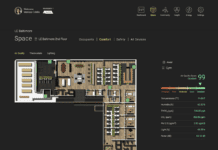This Web Exclusive is contributed by Matt Green, director, SmartStruxure Brand and Technology Training, Americas for Schneider Electric.
Buildings represent a huge opportunity for energy savings. According to the International Energy Agency (IEA), today’s buildings represent about 40% of the world’s energy consumption. But with that opportunity comes several challenges: each building represents its own ecosystem, and each system and component in that ecosystem has a direct impact on the total environment.
In many of today’s buildings, even those incorporating some type of building management system (BMS) or more efficient components, most major systems are siloed in a system-by-system approach. For facility managers (fms), the complexity of managing these facilities has increased exponentially in the past decade. Gone are the days of a large maintenance staff, manually adjusting thermostats, and propping dampers open with a 2’x4′. The era of lean staffing, automation, big data, and IP-enabled platforms has arrived.
Facilities are built to have a long life span. Updating them is a process that can literally take years or even decades, resulting in “FrankenBuildings” that incorporate different systems and components of varying age and manufacture that communicate using different protocols. New systems and equipment create a different challenge, since they have the ability to push out information constantly, creating big data that must be analyzed and turned into actionable intelligence.
There are several challenges facing today’s fms that make it difficult for them to effectively manage and maintain energy efficiency and operational savings across their building ecosystems. First, they typically have more responsibilities and a smaller staff to take care of increasingly complex systems. Some fms have to handle building management while also supporting the IT component of their systems. For many in this role, technology has not always played a large part in their jobs.
In addition, big data has the capacity to enable fms to make smarter, more educated decisions. Unfortunately, the data harvested from building systems is often not presented in an actionable format. The International Facility Management Association (IFMA) reports that this increasing quantity and complexity of information is posing challenges to the profession as a whole, citing that more facility departments have had to add the ability to convert raw data to usable and meaningful information. This adds another step to the process, one that often not a possibility for smaller organizations.
Making It Simple: Using Open Protocols as an Integration Strategy
The industry has made many positive steps to better manage the energy buildings consume. A host of new technological innovations has emerged, enabling the integration of different systems.
Depending on the size of a building, the number of systems to monitor can add up very quickly. By implementing a system that acts as a “universal translator” of open protocols, fms will be able to measure, monitor, and control an entire facility on a single interface, ensuring that all of the components of a building’s new and legacy systems are communicating to optimize functions such as security, fire safety, HVAC, lighting, and metering. Integrating all building systems is also changing how fms (and other buildings stakeholders) are managing their buildings long-term, providing a holistic view across an enterprise.
For example, the energy conscious Davis School District in Davis County, UT wanted to implement a more robust energy management system that made the most of legacy systems while incorporating new technology. With 59 elementary schools, 16 junior high schools, eight high schools, and 340 portable classrooms making up more than 10 million square feet, the district wasn’t able to rip and replace all of its systems to create a new solution. As a result, the Davis School District selected an integrated building management solution, which is bringing together all of its legacy and third-party systems that were already implemented, onto a single user-friendly system.
With the new integrated system, facility managers within the Davis School District now have access to a customized dashboard of real-time data. This provides actionable information, trend visualizations, and one-click reports that ensure all of the buildings are running at maximum efficiency. The new system also provides access to building data via mobile applications, a must for such a large district.
The Davis School District was able to quickly leverage the new technology to improve processes and reduce energy consumption, enabling it to spend those saved dollars on the primary mission of educating 66,000+ students. The district is also incorporating the new system into its curriculum, providing access to the integrated dashboard, which shows real-time energy usage data of HVAC, lighting and other critical building systems in public spaces as well as classrooms, for student interaction.
Putting a Plan in Action
To make streamlined building management reality, fms should take the following steps:
Evaluate: Assess the current needs of the building, boundaries/pain points, goals and objectives, and future needs.
Enlist a trusted resource: This resource should be able to assist in developing a strategy that will help meet building optimization and management goals now and in the future.
Develop and implement: Act on a plan to keep the building operating efficiently and ensure that the building system stays current with technology and business needs.
Train: Continue educating facility staff on the new system to ensure it is being used properly.
Maintain: Perform regular checks to make sure systems are in good operating condition and current with technology, which reduces costs for major upgrades and ensure smoother, faster implementation.
Re-evaluate: Finally, continually evaluate results and look at the changing occupancy and business needs to ensure the system achieving goals and optimizing management of building systems.
As building management technologies continue to increase in complexity, especially in the era of big data, it will be crucial for fms to find a way integrate the “old” and the “new” systems in their facility to achieve maximum efficiency. Through integration, fms have the opportunity to not only save energy and reduce costs, but to optimize their facilities to ensure long-term viability.
















![[VIDEO] Collect Asset Data at the Speed of Walking a Building](https://facilityexecutive.com/wp-content/uploads/2024/02/maxresdefault-324x160.jpg)
Comments are closed.